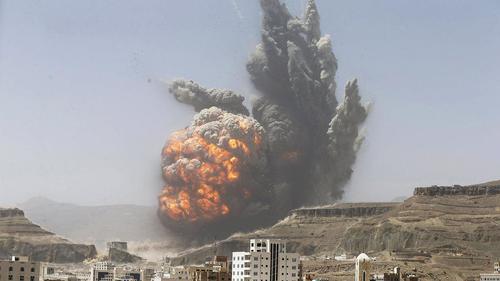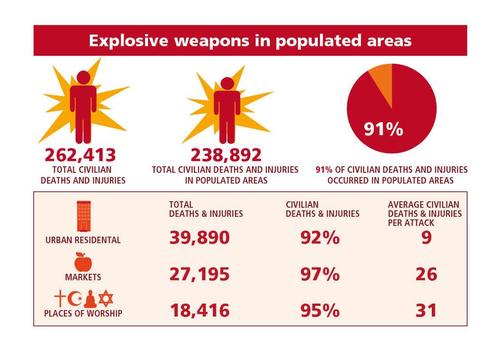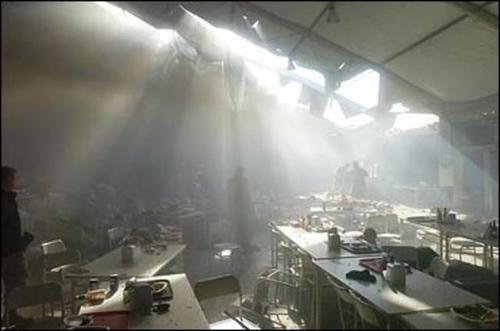(Bof, si conflit avec la Russie ou la Chine, 91% des victimes seront des civils, reste les 1% et ceux qui leur serviront d'esclaves, donc pas grave et le transhumanisme leur permettre de fonder une nouvelle humanité, alors, pas grave. note de rené)
Massive War Study Shows 91% Of All Global Casualties From Explosives Were Civilians
Authored by Jessica Corbett via Common Dreams,
On the heels of Israel's recent bombardment of the Gaza Strip, a London-based charity revealed Tuesday that civilians accounted for 91% of people killed or injured when explosive weapons were used in populated areas worldwide from 2011 to 2020.
The new Action on Armed Violence (AOAV) report (pdf) is based on data collected as part of the group's Explosive Violence Monitoring Project. It emphasizes that the data, taken from English-language media reporting, "is not an attempt to capture every single casualty of every incident around the world."

However, the report provides insight on the devastating impact of using explosive weapons—including air-dropped bombs, artillery shells, improvised explosive devices (IEDs), and mortars—in densely populated areas and demands global commitments to end such violence.
"Since the monitor began, AOAV has recorded the appalling suffering caused across the globe by both manufactured and improvised weapons," the report says. "We call on states and other users to commit politically to stop using explosive weapons with wide area effects in populated areas. The harm recorded over the last 10 years and reflected in this report illustrates the stark urgency needed for a political declaration detailing such a commitment."
AOAV tallied 357,370 deaths or injuries in 28,879 incidents across 123 countries and territories—and at least 262,413 of those casualties or 73% were civilians. Overall, explosive weapons killed 155,118 people—of which 92,588 or 60% were civilians—and injured 202,252 people, of which 169,825 or 84% were civilians.

As the report details:
Civilians were most at risk when explosive weapons were used in populated areas—a well-established pattern of harm.
60% of all recorded incidents took place in populated areas. In those attacks, AOAV recorded 263,798 casualties. Civilians accounted for 91% (238,892) of those killed or injured in populated areas. This compares to 25% of victims being reported as civilians when explosive weapons were used in areas not identified as highly populated areas.
AOAV executive director Iain Overton told The Guardian the report clearly demonstrates that "when explosive weapons are used in towns and cities, civilians will be harmed." That conclusion, he added, was "as true as it is today in Gaza as it was a decade ago in Iraq and beyond."
The highest numbers of civilian deaths and injuries were recorded in Syria (77,534), Iraq (56,316), Afghanistan (28,424), Pakistan (20,719), and Yemen (16,645). Though Gaza and Lebanon ranked ninth and 13th in terms of civilian casualties by numbers, they had the highest percentages of deaths and injuries endured by civilians—90% and 91%, respectively.
IEDs were responsible for 52% of all deaths and injuries while manufactured explosive weapons accounted for another 47%. In other events, both types were used.
AOAV points out that the consequences of such incidents are not limited to immediate deaths and injuries, highlighting that "further casualties have been caused by the reverberating impacts."
"Explosive remnants of war contaminate the land, posing a risk to civilians for generations and frequently preventing local populations from returning or using the land for livelihood activities," explains the report. "The destruction of civilian infrastructure takes years to repair and can leave civilians without access to clean drinking water and sanitation facilities or prevent access to services such as healthcare," AOAV continues. "Such impacts cost further lives, exacerbate the mental health impact for survivors, and see rises in poverty and disease."
In an effort to prevent future casualties and damage, Ireland put forth a "Draft Political Declaration on Strengthening the Protection of Civilians From Humanitarian Harm Arising From the Use of Explosive Weapons in Populated Areas" (pdf) in January, and has welcomed comments on the proposal.
The International Committee of the Red Cross is among the parties that have offered comments (pdf), stating that "in the ICRC's view, the revised draft provides a solid basis for further work towards clear and concrete political commitments to strengthen the protection of civilians from harm caused by these weapons," and detailing some recommendations aimed at "clarifying and strengthening the text."

The Guardian reports that though the draft "has won the support of Belgium and will be considered at a U.N. meeting in Geneva later this year," countries including the U.S., U.K., Israel, and France have reservations "while Russia, accused of repeated breaches of humanitarian law during indiscriminate bombing in Syria, has not participated." According to AOAV's report, "For civilians living in conflict zones this declaration cannot come soon enough—states and civil society must ensure that stronger standards are not watered-down by states that reject the need for constraint."
"States should also seek to improve their policies and practices in light of the harm that is predicted when explosive weapons are used in populated areas," the group adds. "The international community must not only take note of the scale of the figures we have included in this report but be cognizant of the fact that each number represents a life, frequently young, and almost always a civilian."
Earlier this month, Israel's assault of Gaza—which included the destruction of medical facilities and apartment buildings, one of which housed international media offices—killed at least 248 Palestinians, including 66 children, and wounded over 1,900 people, according to local health officials. Although Palestinian groups also launched rockets toward Israel, most were stopped by the nation's air defenses; 13 people have been killed in Israel.
Aucun commentaire:
Enregistrer un commentaire